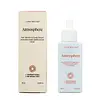What's inside
What's inside
 Key Ingredients
Key Ingredients

 Benefits
Benefits

 Concerns
Concerns

No concerns
 Ingredients Side-by-side
Ingredients Side-by-side

Water
Skin ConditioningCetearyl Alcohol
EmollientCetrimonium Chloride
AntimicrobialGlycerin
HumectantPanthenol
Skin ConditioningOryza Sativa Extract
AbsorbentOryza Sativa Seed Protein
AntioxidantHelianthus Annuus Seed Extract
Skin ConditioningLeontopodium Alpinum Extract
Skin ConditioningSodium PCA
HumectantSodium Lactate
BufferingArginine
MaskingAspartic Acid
MaskingPCA
HumectantGlycine
BufferingAlanine
MaskingSerine
MaskingValine
MaskingIsoleucine
Skin ConditioningPhytic Acid
Proline
Skin ConditioningThreonine
Histidine
HumectantPhenylalanine
MaskingPCA Dimethicone
Skin ConditioningDisodium PEG-12 Dimethicone Sulfosuccinate
CleansingBehentrimonium Chloride
PreservativeSilicone Quaternium-8
PEG-12 Dimethicone
Skin ConditioningTrideceth-10
CleansingButylene Glycol
HumectantAminomethyl Propanol
BufferingGlycolic Acid
BufferingGluconolactone
Skin ConditioningCalcium Gluconate
HumectantSodium Benzoate
MaskingCitric Acid
BufferingPotassium Sorbate
PreservativePhenoxyethanol
PreservativeParfum
MaskingCoumarin
PerfumingAlpha-Isomethyl Ionone
PerfumingLimonene
PerfumingWater, Cetearyl Alcohol, Cetrimonium Chloride, Glycerin, Panthenol, Oryza Sativa Extract, Oryza Sativa Seed Protein, Helianthus Annuus Seed Extract, Leontopodium Alpinum Extract, Sodium PCA, Sodium Lactate, Arginine, Aspartic Acid, PCA, Glycine, Alanine, Serine, Valine, Isoleucine, Phytic Acid, Proline, Threonine, Histidine, Phenylalanine, PCA Dimethicone, Disodium PEG-12 Dimethicone Sulfosuccinate, Behentrimonium Chloride, Silicone Quaternium-8, PEG-12 Dimethicone, Trideceth-10, Butylene Glycol, Aminomethyl Propanol, Glycolic Acid, Gluconolactone, Calcium Gluconate, Sodium Benzoate, Citric Acid, Potassium Sorbate, Phenoxyethanol, Parfum, Coumarin, Alpha-Isomethyl Ionone, Limonene
Aloe Barbadensis Leaf Juice
Skin ConditioningAmaranthus Caudatus Seed Extract
Skin ConditioningLactobacillus
Skin ConditioningPalmitoyl Tripeptide-5
Skin ConditioningTrifolium Pratense Flower Extract
AstringentButylene Glycol
HumectantDextran
Tetrasodium Glutamate Diacetate
Caffeine
Skin ConditioningPolygonum Multiflorum Extract
Skin ConditioningNiacin
SmoothingGlycerin
HumectantAngelica Archangelica Extract
Skin ConditioningEquisetum Arvense Extract
AstringentCentella Asiatica Extract
CleansingScutellaria Lateriflora Extract
Skin ConditioningXanthan Gum
EmulsifyingZinc Oxide
Cosmetic ColorantArginine
MaskingCitric Acid
BufferingAloe Barbadensis Leaf Juice, Amaranthus Caudatus Seed Extract, Lactobacillus, Palmitoyl Tripeptide-5, Trifolium Pratense Flower Extract, Butylene Glycol, Dextran, Tetrasodium Glutamate Diacetate, Caffeine, Polygonum Multiflorum Extract, Niacin, Glycerin, Angelica Archangelica Extract, Equisetum Arvense Extract, Centella Asiatica Extract, Scutellaria Lateriflora Extract, Xanthan Gum, Zinc Oxide, Arginine, Citric Acid
 Reviews
Reviews

Alternatives
Ingredients Explained
These ingredients are found in both products.
Ingredients higher up in an ingredient list are typically present in a larger amount.
Arginine is an amino acid that is important for human development. Your body uses is it to produce hair keratin and skin collagen.
As a cosmetic ingredient, Arginine has antioxidant properties and can also help repair damaged skin. This ingredient is derived either synthetically or from animals.
Arginine isn't fungal acne safe when used in the presence of other lipids (fats, fatty acids, oils, esters, etc). Oils and fats occur naturally within the skin, so take caution when using Arginine if you're prone to fungal acne.
Learn more about ArginineButylene Glycol (or BG) is used within cosmetic products for a few different reasons:
Overall, Butylene Glycol is a safe and well-rounded ingredient that works well with other ingredients.
Though this ingredient works well with most skin types, some people with sensitive skin may experience a reaction such as allergic rashes, closed comedones, or itchiness.
Learn more about Butylene GlycolCitric Acid is an alpha hydroxy acid (AHA) naturally found in citrus fruits like oranges, lemons, and limes.
Like other AHAs, citric acid can exfoliate skin by breaking down the bonds that hold dead skin cells together. This helps reveal smoother and brighter skin underneath.
However, this exfoliating effect only happens at high concentrations (20%) which can be hard to find in cosmetic products.
Due to this, citric acid is usually included in small amounts as a pH adjuster. This helps keep products slightly more acidic and compatible with skin's natural pH.
In skincare formulas, citric acid can:
While it can provide some skin benefits, research shows lactic acid and glycolic acid are generally more effective and less irritating exfoliants.
Most citric acid used in skincare today is made by fermenting sugars (usually from molasses). This synthetic version is identical to the natural citrus form but easier to stabilize and use in formulations.
Read more about some other popular AHA's here:
Learn more about Citric AcidGlycerin is already naturally found in your skin. It helps moisturize and protect your skin.
A study from 2016 found glycerin to be more effective as a humectant than AHAs and hyaluronic acid.
As a humectant, it helps the skin stay hydrated by pulling moisture to your skin. The low molecular weight of glycerin allows it to pull moisture into the deeper layers of your skin.
Hydrated skin improves your skin barrier; Your skin barrier helps protect against irritants and bacteria.
Glycerin has also been found to have antimicrobial and antiviral properties. Due to these properties, glycerin is often used in wound and burn treatments.
In cosmetics, glycerin is usually derived from plants such as soybean or palm. However, it can also be sourced from animals, such as tallow or animal fat.
This ingredient is organic, colorless, odorless, and non-toxic.
Glycerin is the name for this ingredient in American English. British English uses Glycerol/Glycerine.
Learn more about Glycerin